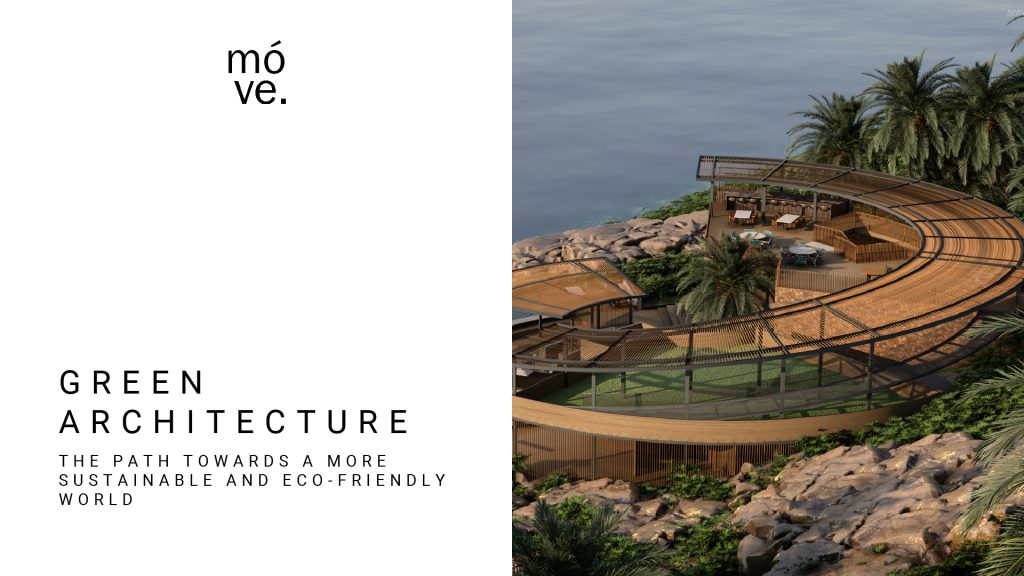ECO-LUXURY

THE PATH TOWARDS A MORE SUSTAINABLE AND ECO-FRIENDLY WORLD
Sustainable architecture is not just a trend shaping recent generations; it is also a necessity to significantly reduce the environmental impact that is affecting our planet. It offers a way to continue building a more sustainable future.
If people were to implement green architecture on a large scale, we could drastically cut carbon emissions and reduce resource waste. At the same time, it would create efficient, healthy spaces that coexist harmoniously with the environment—contributing to the well-being of our planet and benefiting all future generations.
Modern architecture can be a key pillar in the fight against climate change, and today we’ll explore how this growing trend could play a role in saving our planet.
WHAT IS GREEN AND SUSTAINABLE ARCHITECTURE?
Green architecture, also known as ecological architecture, is a design approach that seeks to minimize the environmental impact of buildings throughout their life cycle, while promoting sustainable construction.
It is based on the efficient use of resources during the construction process, integration with the natural environment, and a noticeable reduction in energy consumption.
Key aspects of green architecture:
- WATER CONSERVATION: Green buildings are designed to minimize water consumption and reduce the amount of wasted liquid.
- ENERGY-EFFICIENT DESIGNS: These designs focus on significantly lowering energy use and reducing greenhouse gas emissions on a large scale.
- INTEGRATION WITH THE NATURAL ENVIRONMENT: Green architecture is planned to harmonize with its surroundings, minimizing impact on biodiversity and local ecosystems.
- USE OF SUSTAINABLE MATERIALS: All materials used in green construction are selected for their low environmental impact, durability, and ability to be recycled or reused.
BENEFITS OF GREEN ARCHITECTURE
In a world where climate change and environmental degradation are urgent challenges that affect us all, green architecture has become a key pillar for sustainable development.
This ecological design approach aims to reduce the environmental impact of buildings by creating breathable, natural, and intelligent spaces that help guarantee a better quality of life for both people and the planet.
More than just a trend or passing fashion among the newer, more climate-aware generations, this type of architecture represents a meaningful way to improve human well-being while actively protecting the Earth.
Let’s briefly explore its main benefits:
ENERGY EFFICIENCY
Green buildings are designed to reduce energy consumption without sacrificing comfort through:
- Advanced thermal insulation.
- Bioclimatic design.
- Use of renewable energy sources.
REDUCTION OF CARBON FOOTPRINT
Traditional construction generates a massive amount of pollutant emissions. So, how does green architecture help address this issue?
- Use of recycled, recyclable, or low-impact materials.
- Implementation of green roofs and walls that absorb CO? and purify the air.
- Reduced dependence on fossil fuels and lower CO? emissions.
WELL-BEING AND HEALTH FOR OCCUPANTS
Traditional materials and designs can affect human health. Green architecture helps create healthier environments by:
- Reducing indoor pollutants through the use of non-toxic materials.
- Improving indoor air quality with natural ventilation and plant-based air purification.
- Enhancing thermal and lighting comfort, reducing stress and visual fatigue.
GREEN ARCHITECTURE AROUND THE WORLD
Green or ecological architecture has been implemented around the world, demonstrating that sustainability and innovative design can go hand in hand.
These projects stand out for their commitment to the environment, energy efficiency, and integration with their surroundings:
- THE EDGE (Netherlands):
Considered one of the most sustainable buildings in the world, this project uses smart sensors to optimize energy consumption and maximize resource efficiency. - ONE CENTRAL PARK (Australia):
This skyscraper in Sydney incorporates vertical gardens and a system of solar reflectors that optimize natural light entry, significantly reducing electricity usage.
BOSCO VERTICALE (Italy):
Located in Milan, this residential tower complex includes over 900 trees and 2,000 plants that help reduce pollution and improve urban biodiversity.
